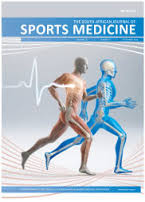Gastrocnemius muscle architecture in distance runners with and without Achilles tendinopathy
DOI:
https://doi.org/10.17159/2078-516X/2022/v34i1a12576Abstract
Background: Achilles tendinopathy is a common condition amongst distance runners due to the cumulative repetitive overload of the tendon. Gastrocnemius weakness and inflexibility can predispose to this condition. These
predisposing functional deficits could have architectural underpinnings, but the gastrocnemius architecture of distance runners with Achilles tendinopathy has not been previously described or compared to the architecture of healthy distance runners.
Objectives: We aimed to investigate the differences in gastrocnemius architecture between distance runners with
Achilles tendinopathy and uninjured counterparts.
Methods: Twenty distance runners (10 with Achilles tendinopathy; 10 uninjured) were recruited to this study. Ultrasound measurement of the gastrocnemius muscle architecture (pennation angle; fascicle length; muscle thickness; muscle belly length; muscle volume; physiological cross-sectional area) was performed.
Results: Gastrocnemius Medial Head (GM) fascicle length was significantly greater (p = 0.02), whilst the physiological cross-sectional area (PCSA) was significantly less (p = 0.01) in the case group. Gastrocnemius Lateral Head (GL) pennation angle (p = 0.01) and PCSA (p = 0.01) were significantly lower, whilst fascicle length was significantly greater (p = 0.01) in the case group. There were no significant between-group differences in GM and GL muscle thickness, muscle belly length, or muscle volume.
Conclusion: Components of gastrocnemius architecture differ significantly between distance runners with Achilles
tendinopathy and uninjured controls in our study sample. This study cannot infer whether these results are secondary or predisposing to the condition. Further longitudinal investigation is required to explore these relationships further.
Downloads
Downloads
Published
Issue
Section
License
Copyright (c) 2022 South African Journal of Sports Medicine

This work is licensed under a Creative Commons Attribution 4.0 International License.
The South African Journal of Sports Medicine reserves copyright of the material published. The work is licensed under a Creative Commons Attribution 4.0 (CC BY 4.0) International License. Material submitted for publication in the South African Journal of Sports Medicine is accepted provided it has not been published elsewhere. The South African Journal of Sports Medicine does not hold itself responsible for statements made by the authors.
How to Cite
- Abstract 605
- PDF 547






.png)